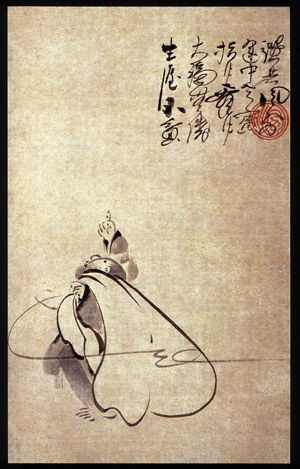| architecture |
| calligraphy |
| ceramics |
| clothing |
| comics |
| gardens |
| lacquerwork |
| literature |
| movies |
| music |
| painting |
| poetry |
| sculpture |
| tea ceremony |
| television |
| theatre |
| weaponry |
| thematic routes |
| timeline |
| the site |
context: painting > Zen painting > Artists
Fugai Ekun 1568-1654

|
Hotei |
If you've looked at my two pages on Zen painting's historical trends, the dates might clue you in to the fact that we are now going to move away from the colossal professional skills of the likes of Sesshu and Sesson, and towards people who were Zen priests or monks first, and painters second. Often they were painters at all only late in life. We also move to an era of valuing eccentric figures. Fugai launches us into this very well...
Fugai lived in tiny caves for many years, and is widely known as 'Cave Fugai' for this reason. When he was hungry, he'd paint a quick Daruma (mostly) and leave it outside his cave, and someone in the local village would leave some rice in exchange. There are still plenty of his works in those villages.
So we couldn't call him a professional artist, but there is no shortage of skill on show here - the control of line and tone, the confident composition and rhythms, are all flawless and wonderful. I'd be very interested to know if there are any cases of artists using motion lines, as shown here, before Fugai. I don't think I've seen any. The poem reads:
His life is not poor
He has riches beyond measure
Pointing to the moon, gazing at the moon
This old guest follows the way
